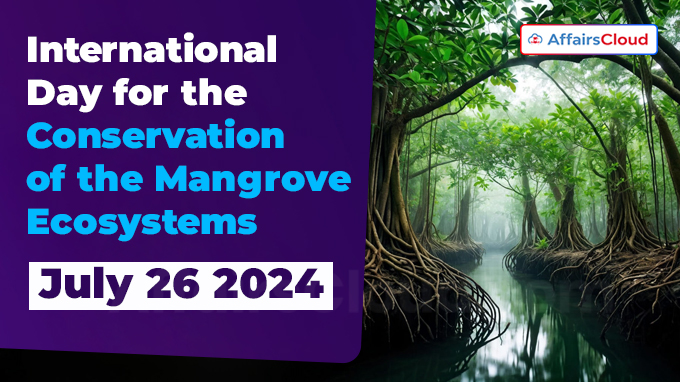 The United Nations Educational, Scientific and Cultural Organisation (UNESCO) International Day for the Conservation of the Mangrove Ecosystems or World Mangrove Day is annually observed across the globe on 26 July to raise awareness of the importance of mangrove ecosystems, a unique, prolific ecosystems located on the boundary between land and sea, where no other trees can survive.
The United Nations Educational, Scientific and Cultural Organisation (UNESCO) International Day for the Conservation of the Mangrove Ecosystems or World Mangrove Day is annually observed across the globe on 26 July to raise awareness of the importance of mangrove ecosystems, a unique, prolific ecosystems located on the boundary between land and sea, where no other trees can survive.
- 26 July, 2024 marks the observance of the 9th International Day for the Conservation of the Mangrove Ecosystems.
- This Day recognises mangrove ecosystems as “a unique, special, and vulnerable ecosystem” and promotes solutions for their sustainable management, conservation, and uses.
Note: The term mangrove is used to mean woody plants or plant communities and the habitat in which these plants are found. Mangroves are among the world’s most productive ecosystems.
Background:
i.In 2015, UNESCO at its 38th session of the General Conference, adopted a resolution 38 C/66 for the proclaiming the 26 July of every year as the International Day for the Conservation of the Mangrove Ecosystem.
ii.The 1st ever International Day for the Conservation of the Mangrove Ecosystem was observed on 26 July, 2016.
iii.26 July commemorates the death anniversary of Greenpeace activist Hayhow Daniel Nanoto of Micronesia, who died in 1998 during a massive protest to re-establish the mangrove wetlands in Muisne, Ecuador.
Significance:
i.Mangroves are assemblages of salt-tolerant trees and shrubs that grow in the intertidal regions of the tropical and subtropical coastlines.
ii.These ecosystems support coastal communities’ well-being, food security, and protection worldwide, providing a valuable nursery habitat for fish and crustaceans.
iii.They also act as a natural coastal defense against storm surges, tsunamis, rising sea levels, and erosion.
- Their soils are effective carbon sinks, sequestering vast amounts of carbon.
iv.The flora and fauna in mangrove ecosystems have distinct adaptations to survive in low-oxygen soil conditions.
Global Mangrove Alliance (GMA):
i.The GMA launched in 2018, is an extraordinary collaboration bringing together Non-Governmental Organisations (NGOs), governments, scientists, industry, etc. towards a common goal of conserving and restoring mangrove ecosystems.
ii.The GMA is working globally, nationally, and locally to enact its ambitious plan for the world’s mangroves that contains 3 critical goals to be achieved by 2030:
- Halt mangrove loss; Restore half of the world’s lost mangroves; and Double mangrove protection.
GMA’s Report on Mangroves:
The GMA released The State of the World’s Mangroves 2024 report, highlighting the progress made in protecting mangrove ecosystems.
- The report covers areas such as science and understanding, collaboration, management interventions, and policy, legal, and financial tools.
According to the report:
- Globally, 40% of the world’s remaining mangrove forests are in protected areas.
- Over 5,700 plant and animal species, across 21 phyla, have been recorded in Indian mangroves alone.
- Mangroves hold, on average, 394 tonnes of carbon per hectare in their living biomass and the top meter of soil.
- Mangroves support nearly 800 billion young fish, prawns, bivalves, and crabs annually.
- The conversion of mangroves for aquaculture, oil palm plantations, and rice cultivation accounted for 43.3% of global mangrove loss between 2000 and 2020.
Current Threats:
i.Mangroves are disappearing 3-5 times faster than global forest losses. Mangrove coverage has halved in the past 40 years.
ii.Over three-quarters of the world’s mangroves are threatened, impacting aquatic and terrestrial organisms.
Role of UNESCO:
i.UNESCO is committed to protecting mangrove ecosystems globally, by including them in its Biosphere Reserves, Global Geoparks, and natural World Heritage sites.
- The UNESCO Marine World Heritage sites host 9% of global mangrove carbon assets.
ii.UNESCO works at scientific and policy levels to protect, manage, or restore global blue carbon ecosystems (mangroves, seagrasses, and tidal/salt marshes) to address climate change.
Mangroves in India:
As per the India State of Forest Report, 2021, the mangrove cover in the country has been estimated at 4992 square kilometre(sq km) with net increment of 17 sq.km in the year 2021 as compared to 2019.
- West Bengal(WB) has the highest percentage of mangrove cover (42.45%) in India. It is followed by Gujarat(23.66%) and Andaman, and Nicobar(A&N) Islands(12.39%).
- Sundarbans is the largest mangrove forest in the world. The forest has been enlisted in the UNESCO World Heritage Sites
About the United Nations Educational, Scientific and Cultural Organisation (UNESCO):
Director-General – Audrey Azoulay
Headquarters– Paris, France
Established – 16 November 1945




